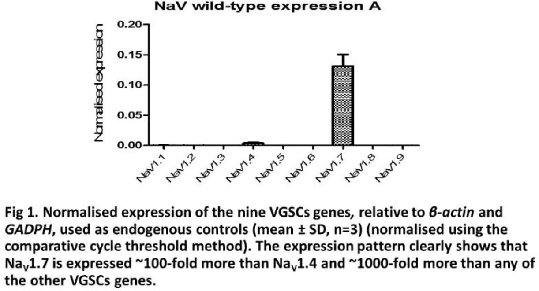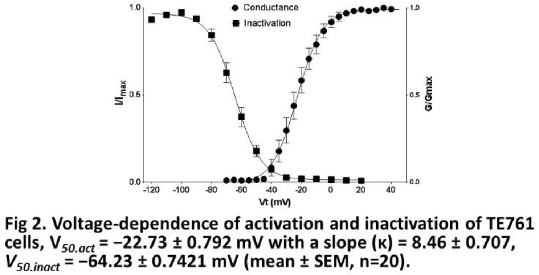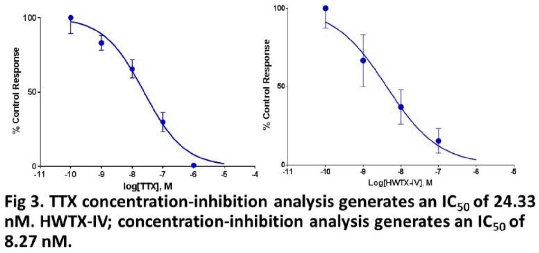Print version
Search Pub Med
| 101P London, UK Pharmacology 2017 |
Characterization of voltage-gated sodium channel subtypes expressed in the human rhabdomyosarcoma cell line TE671
Introduction: The TE671 cell line has been widely used as a model of human medulloblastoma1. Further analysis showed that its phenotypic and cytogenetic properties were similar to the human muscle RD cell line, hence, TE671 was ascribed as rhabdomyosarcoma rather than medulloblastoma2. Previous studies showed that TE671 cells exhibited voltage-gating properties, cation selectivity and neurotoxin sensitivity-characteristic of ‘classical’ sodium channels of excitable cell2.
Method: This study further characterizes the voltage-gated sodium channel (VGSC) subtypes expressed in the TE671 cell line via: (1) Gene expression of the VGSCs determined using qPCR to measure RNA levels based on two reference genes, β-actin and GAPDH, (2) Electrophysiology studies where membrane currents were recorded under voltage clamp conditions using the patch clamp technique in whole-cell configurations.
Results: The expression pattern shows that NaV1.7 is expressed ∼100-fold more than NaV1.4 and ∼1000-fold more than any other VGSC subtypes (Fig. 1). The VGSCs expressed in TE671 cells display kinetic and voltage-activation characteristics resembling VGSCs expressed in many other cells. Macroscopic sodium currents display a typical transient time course with a rapid rise to a peak followed by an exponential decay. The rates of early activation and subsequent inactivation accelerate and approach a maximum in response to test potential, of greater depolarization. The magnitude of peak sodium current increased from negligible values at Vt = -40 mV and reached a maximum at Vt= ∼0 mV. The half-maximal activation (V1/2) was 22.7±0.8 mV with a slope (κ) of 8.46±0.71 mV, while the voltage-dependence of fast inactivation of the current was 64.2±0.7 mV (Fig 2). The VGSC of TE671 cells fall into the Tetrodotoxin (TTX)-sensitive category; TTX IC50 recorded was 24.3 nM. The VGSC current was also potently blocked by the NaV1.7-selective spider toxin, HWTX-IV, with an IC50 of 8.27 nM (Fig 3).
Conclusion: Although we predicted that the muscle type NaV1.4 may be the channel expressed in TE671 cells, the present study suggests that the NaV1.7 subtype is predominantly expressed as shown in both the gene expression and electrophysiology studies (indicated by high sensitivity to the NaV1.7 selective, HWTX-IV). This elevated the importance of the TE671 cell line as a model for pain studies.
References:
1. Stratton et al. (1989). Carcinogenesis 10(5): 899-905.
2. Gambale et al. (1990). Molecular Brain Research 7: 123-129.




